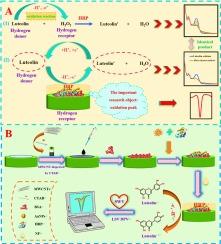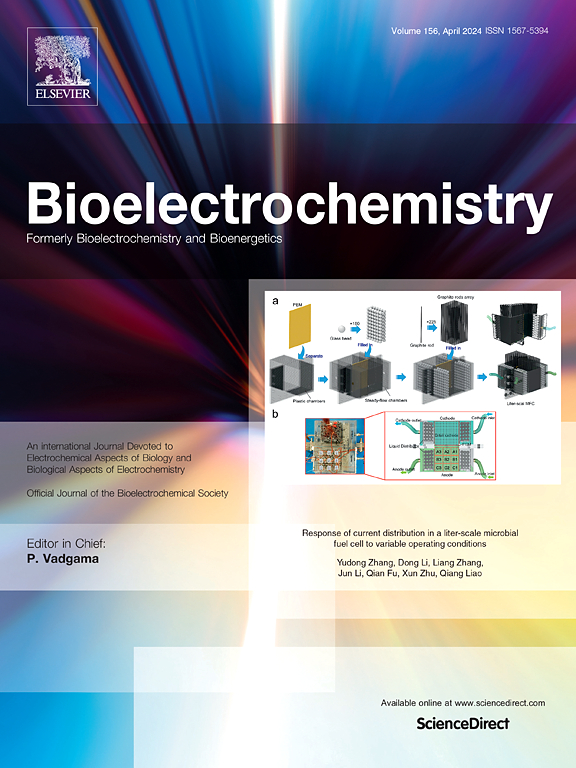基于功能纳米材料和辣根过氧化物酶的电化学生物传感器测定花生壳、金银花和紫苏中的木犀草素
IF 4.8
2区 化学
Q1 BIOCHEMISTRY & MOLECULAR BIOLOGY
引用次数: 0
摘要
特别是考虑到叶黄素在一定浓度下对健康的特殊益处,构建一种能准确检测叶黄素含量的生物传感器至关重要。在这项工作中,HRP 催化的叶黄素反应可成功应用于电催化过程,电极上发生的电子丢失和脱氢的氧化过程取代了 HRP 生物催化过程中 H2O2 的氢受体作用。这种氧化反应具有明显的电流响应,从而实现了对木犀草素的精确测量。该生物传感器使用 CTAB 分散 MWCNT,使用 BSA 提高 MWCNT 的疏水性,有利于后续 AuNPs 固定 HRP。比较了检测木犀草素的三种检测方法(LSV、DPV和SWV),结果表明SWV方法的线性范围更广(1×10-8-2×10-5 M),检出限更低(8×10-10 M)。高效液相色谱法和生物传感器法测定中药中的木犀草素含量基本一致。因此,该生物传感器可成功替代高效液相色谱法检测中药中的木犀草素。本文章由计算机程序翻译,如有差异,请以英文原文为准。

Electrochemical biosensor based on functional nanomaterials and horseradish peroxidase for the determination of luteolin in peanut shell, honeysuckle and perilla
Constructing a biosensor to detect luteolin content accurately is essential, especially considering its specific health benefits at certain concentrations. In this work, the reaction of HRP catalyzed luteolin could be successfully applied in electrocatalytic processes, the oxidation process of electron loss and dehydrogenation occurring on the electrode replaced the hydrogen receptor role of H2O2 in the HRP biocatalytic process. This oxidation reaction had an apparent current response, thus achieving accurate measurement of luteolin. On this biosensor, CTAB was used to disperse MWCNTs, and BSA was used to improve the hydrophobicity of MWCNTs, which was conducive to the subsequent AuNPs fixation of HRP. Three detection methods (LSV, DPV and SWV) for the detection of luteolin were compared and showed that SWV method had a wider linear range (1 × 10−8–2 × 10−5 M) and lower detection limit (8 × 10−10 M). The determination of luteolin in Traditional Chinese Medicine (TCM) by high performance liquid chromatography (HPLC) and biosensor was almost identical. Therefore, this biosensor could successfully replace HPLC in detecting luteolin in TCM.
求助全文
通过发布文献求助,成功后即可免费获取论文全文。
去求助
来源期刊

Bioelectrochemistry
生物-电化学
CiteScore
9.10
自引率
6.00%
发文量
238
审稿时长
38 days
期刊介绍:
An International Journal Devoted to Electrochemical Aspects of Biology and Biological Aspects of Electrochemistry
Bioelectrochemistry is an international journal devoted to electrochemical principles in biology and biological aspects of electrochemistry. It publishes experimental and theoretical papers dealing with the electrochemical aspects of:
• Electrified interfaces (electric double layers, adsorption, electron transfer, protein electrochemistry, basic principles of biosensors, biosensor interfaces and bio-nanosensor design and construction.
• Electric and magnetic field effects (field-dependent processes, field interactions with molecules, intramolecular field effects, sensory systems for electric and magnetic fields, molecular and cellular mechanisms)
• Bioenergetics and signal transduction (energy conversion, photosynthetic and visual membranes)
• Biomembranes and model membranes (thermodynamics and mechanics, membrane transport, electroporation, fusion and insertion)
• Electrochemical applications in medicine and biotechnology (drug delivery and gene transfer to cells and tissues, iontophoresis, skin electroporation, injury and repair).
• Organization and use of arrays in-vitro and in-vivo, including as part of feedback control.
• Electrochemical interrogation of biofilms as generated by microorganisms and tissue reaction associated with medical implants.
 求助内容:
求助内容: 应助结果提醒方式:
应助结果提醒方式:


